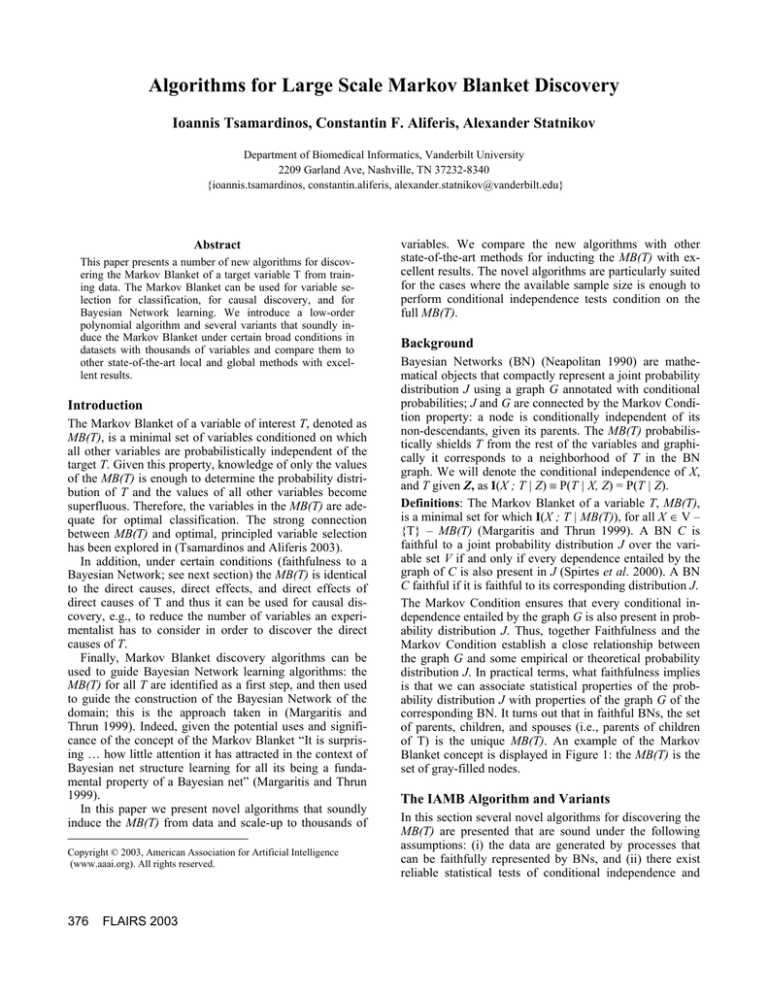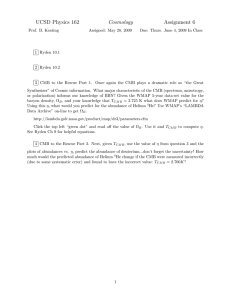
Algorithms for Large Scale Markov Blanket Discovery
Ioannis Tsamardinos, Constantin F. Aliferis, Alexander Statnikov
Department of Biomedical Informatics, Vanderbilt University
2209 Garland Ave, Nashville, TN 37232-8340
{ioannis.tsamardinos, constantin.aliferis, alexander.statnikov@vanderbilt.edu}
Abstract
This paper presents a number of new algorithms for discovering the Markov Blanket of a target variable T from training data. The Markov Blanket can be used for variable selection for classification, for causal discovery, and for
Bayesian Network learning. We introduce a low-order
polynomial algorithm and several variants that soundly induce the Markov Blanket under certain broad conditions in
datasets with thousands of variables and compare them to
other state-of-the-art local and global methods with excellent results.
Introduction
The Markov Blanket of a variable of interest T, denoted as
MB(T), is a minimal set of variables conditioned on which
all other variables are probabilistically independent of the
target T. Given this property, knowledge of only the values
of the MB(T) is enough to determine the probability distribution of T and the values of all other variables become
superfluous. Therefore, the variables in the MB(T) are adequate for optimal classification. The strong connection
between MB(T) and optimal, principled variable selection
has been explored in (Tsamardinos and Aliferis 2003).
In addition, under certain conditions (faithfulness to a
Bayesian Network; see next section) the MB(T) is identical
to the direct causes, direct effects, and direct effects of
direct causes of T and thus it can be used for causal discovery, e.g., to reduce the number of variables an experimentalist has to consider in order to discover the direct
causes of T.
Finally, Markov Blanket discovery algorithms can be
used to guide Bayesian Network learning algorithms: the
MB(T) for all T are identified as a first step, and then used
to guide the construction of the Bayesian Network of the
domain; this is the approach taken in (Margaritis and
Thrun 1999). Indeed, given the potential uses and significance of the concept of the Markov Blanket “It is surprising … how little attention it has attracted in the context of
Bayesian net structure learning for all its being a fundamental property of a Bayesian net” (Margaritis and Thrun
1999).
In this paper we present novel algorithms that soundly
induce the MB(T) from data and scale-up to thousands of
Copyright © 2003, American Association for Artificial Intelligence
(www.aaai.org). All rights reserved.
376
FLAIRS 2003
variables. We compare the new algorithms with other
state-of-the-art methods for inducting the MB(T) with excellent results. The novel algorithms are particularly suited
for the cases where the available sample size is enough to
perform conditional independence tests condition on the
full MB(T).
Background
Bayesian Networks (BN) (Neapolitan 1990) are mathematical objects that compactly represent a joint probability
distribution J using a graph G annotated with conditional
probabilities; J and G are connected by the Markov Condition property: a node is conditionally independent of its
non-descendants, given its parents. The MB(T) probabilistically shields T from the rest of the variables and graphically it corresponds to a neighborhood of T in the BN
graph. We will denote the conditional independence of X,
and T given Z, as I(X ; T | Z) ≡ P(T | X, Z) = P(T | Z).
Definitions: The Markov Blanket of a variable T, MB(T),
is a minimal set for which I(X ; T | MB(T)), for all X ∈ V –
{T} – MB(T) (Margaritis and Thrun 1999). A BN C is
faithful to a joint probability distribution J over the variable set V if and only if every dependence entailed by the
graph of C is also present in J (Spirtes et al. 2000). A BN
C faithful if it is faithful to its corresponding distribution J.
The Markov Condition ensures that every conditional independence entailed by the graph G is also present in probability distribution J. Thus, together Faithfulness and the
Markov Condition establish a close relationship between
the graph G and some empirical or theoretical probability
distribution J. In practical terms, what faithfulness implies
is that we can associate statistical properties of the probability distribution J with properties of the graph G of the
corresponding BN. It turns out that in faithful BNs, the set
of parents, children, and spouses (i.e., parents of children
of T) is the unique MB(T). An example of the Markov
Blanket concept is displayed in Figure 1: the MB(T) is the
set of gray-filled nodes.
The IAMB Algorithm and Variants
In this section several novel algorithms for discovering the
MB(T) are presented that are sound under the following
assumptions: (i) the data are generated by processes that
can be faithfully represented by BNs, and (ii) there exist
reliable statistical tests of conditional independence and
measures of associations for the given variable distribution, sample size, and sampling of the data. We discuss the
rationale and justification of the assumptions in the Discussion section.
IAMB Description: Incremental Association Markov
Blanket (IAMB) (Figure 2) consists of two phases, a forward and a backward one. An estimate of the MB(T) is
kept in the set CMB. In the forward phase all variables that
belong in MB(T) and possibly more (false positives) enter
CMB while in the backward phase the false positives are
identified and removed so that CMB = MB(T) in the end.
The heuristic used in IAMB to identify potential Markov
Blanket members in phase I is the following: start with an
empty candidate set for the CMB and admit into it (in the
next iteration) the variable that maximizes a heuristic function f(X ; T | CMB). Function f should return a non-zero
value for every variable that is a member of the Markov
Blanket for the algorithm to be sound, and typically it is a
measure of association between X and T given CMB. In
our experiments we used as f the Mutual Information similar to what suggested in (Margaritis and Thrun 1999,
Cheng et al. 1998): f(X ; T | CMB) is the Mutual Information between S and T given CMB. It is important that f is an
informative and effective heuristic so that the set of candidate variables after phase I is as small as possible for two
reasons: one is time efficiency (i.e., do not spend time considering irrelevant variables) and another is sample efficiency (do not require sample larger than what is absolutely necessary to perform conditional tests of independence). In backward conditioning (Phase II) we remove
one-by-one the features that do not belong to the MB(T) by
testing whether a feature X from CMB is independent of T
given the remaining CMB.
IAMB Proof of Correctness (sketch): If a feature belongs to MB(T), then it will be admitted in the first step
because it will be dependent on T given any subset of the
feature set because of faithfulness and because the MB(T)
is the minimal set with that property. If a feature is not a
member of MB(T), then conditioned on MB(T), or any superset of MB(T), it will be independent of T and thus will
be removed from CMB in the second phase. Using this
argument inductively we see that we will end up with the
unique MB(T).
InterIAMBnPC Description: The smaller the conditioning test given a finite sample of fixed size, the more accurate the statistical tests of independence and the measure of
associations. The InterIAMBnPC algorithm uses two
methods to reduce the size of the conditioning sets: (a) it
interleaves the admission phase of IAMB (phase I) with
the backward conditioning (phase II) attempting to keep
the size of MB(T) as small as possible during all steps of
the algorithm’s execution. (b) it substitutes the backward
conditioning phase as implemented in IAMB with the PC
algorithm instead (Spirtes et al. 2000), a Bayesian Network
learning algorithm that determines direct edges between
variables in a more sample–efficient manner, and that is
sound given the stated assumptions (see next section);
thus, interIAMBnPC is expected to be more sampleefficient than IAMB. In addition, interIAMBnPC is still
practical because PC is running only on small sets of variables, not the full set of variables.
InterIAMBnPC Proof of Correctness (sketch): All parents and children of T will enter CMB by the property of f
mentioned above. Since PC is sound, it will never remove
these variables. Since all effects enter CMB, conditioned
on them, all the spouses (parents of children) of T will be
dependent with T given CMB and enter CMB at some
point. Again, because PC is sound, it will not permanently
remove them (they may be removed temporarily but will
enter CMB at a subsequent iteration; we do not elaborate
due to space limitations), and they will be included in the
final output.
Two other IAMB variants we experimented with are interIAMB and IAMBnPC which are similar to interIAMBnPC but they employ only either interleaving the
first two phases or using PC for the backward phase, respectively. Even though IAMB provides theoretical guarantees only in the sample limit, the quality of the output
and the approximation of the true MB(T) degrades gracefully in practical settings with finite sample (see experimental section). IAMB and its variants are expected to
perform best in problems where the MB(T) is small relatively to the available data samples, but the domain may
contain hundreds of thousands of variables.
Time Complexity: Typically, the performance of BNinduction algorithms based on tests of conditional independence is measured in the number of association calculations and conditional independence tests executed (both
operations take similar computation effort and we will not
distinguish between the two) (Spirtes et al. 2000, Cheng et
al. 1998, Margaritis and Thrun 1999). Phase II performs
O(|CMB|) conditional independence tests. Phase I performs
N association computations for each variable that enters
CMB, where N is the number of variables, and so the algorithm performs O(|CMB|×N) tests. In the worst case
|CMB|=N giving an order of O(N2). In all experiments of
IAMB we observed |CMB|=O(MB(T)) giving an average
case order of O(MB(T) ×N) tests. For Mutual Information
there exists an algorithm linear to the size of the data
(Margaritis and Thrun 1999). The other IAMB variants
have higher worst-case time complexity (since for example
the PC is exponential to the number of variables) tradingoff computation for higher performance. Nevertheless,
since in our experiments we observed that the size of the
CMB is relative small to the total number of variables, the
additional time overhead of the variants versus the vanilla
IAMB was minimal.
Other Markov Blanket algorithms
To our knowledge, the only other algorithm developed
explicitly for discovering the MB(T) and that scales-up is
the Grow-Shrink (GS) algorithm (Margaritis and Thrun
1999). It is theoretically sound but uses a static and potentially inefficient heuristic in the first phase. IAMB enhances GS by employing a dynamic heuristic. The KollerSahami algorithm (KS) (Koller and Sahami 1996) is the
first algorithm for feature selection to employ the concept
FLAIRS 2003
377
of the Markov Blanket. KS is a heuristic algorithm and
provides no theoretical guarantees.
The GS algorithm is structurally similar to IAMB and
follows the same two-phase structure. However, there is
one important difference: GS statically orders the variables
when they are considered for inclusion in phase I, according to their strength of association with T given the empty
set. It then admits into CMB the next variable in that ordering that is not conditionally independent from T given
CMB. One problem with this heuristic is that when the
MB(T) contains spouses of T. In that case, the spouses are
typically associated with T very weakly given the empty
set and are considered for inclusion in the MB(T) late in
the first phase (associations between spouses and T are
only through confounding /common ancestors variables,
thus they are weaker than those ancestors’ associations
with T). In turn, this implies that more false positives will
enter CMB at phase I and the conditional tests of independence will become unreliable much sooner than when
using IAMB’s heuristic. In contrast, conditioned on the
common children, spouses may have strong association
with T and, when using IAMB’s heuristic, enter the CMB
early. An analogous situation is in constraint satisfaction
where dynamic heuristics typically outperform static ones.
We provide evidence to support this hypothesis in the experiment section. We would also like to note that the proof
of correctness of GS is indeed correct only if one assumes
faithfulness, and not just the existence of a unique MB(T)
as is stated in the paper: a non-faithful counter example is
when T is the exclusive or of X and Y on which the GS will
fail to discover the MB(T), even though it is unique.
The KS algorithm (Koller, Sahami 1996) is the first one
that employed the concept of the Markov Blanket for feature selection. The algorithm accepts two parameters: (i)
the number v of variables to retain and (ii) a parameter k
which is the maximum number of variables the algorithm
is allowed to condition on. For k=0 KS is equivalent to
univariately ordering the variables and selecting the first v.
The Koller-Sahami paper does not explicitly claim to identify the MB(T); however, if one could guess the size of the
MB(T) and set the parameter v to this number then ideally
the algorithm should output MB(T). Viewed this way we
treated the KS algorithm as an algorithm for approximating
the MB(T) using only v variables. Unlike IAMB, the
IAMB variants, and GS, the KS algorithm does not provide any theoretical guarantees of discovering the MB(T).
PC (Spirtes et al. 2000) is a prototypical BN learning
algorithm that is sound given the stated set of assumptions.
PC learns the whole network (and so it does not scale-up
well) from which the MB(T) can be easily extracted as the
set of parents, children, and spouses of T. The PC algorithm starts with a fully connected unoriented Bayesian
Network graph and has three phases. In phase I the algorithm finds undirected edges by using the criterion that
variable A has an edge to variable B iff for all subsets of
features there is no subset S, s.t. I(A ; B | S). In phases II
and III the algorithm orients the edges by performing
global constraint propagation. IAMBnPC could be
378
FLAIRS 2003
thought of as improving GS by employing a more efficient, but still sound, way (i.e., PC) for the backward
phase and a dynamic heuristic for the forward phase, or as
improving PC by providing an admissible first phase heuristic that focuses PC on a local neighborhood.
We now provide a hypothetical trace of IAMB on the
BN of Figure 1. We assume the reader’s familiarity with
the d-separation criterion (Spirtest et al. 2000) which is a
graph-theory criterion that implies probabilistic conditional
independence. In the beginning CMB is empty and the
variable mostly associated with T given the empty set will
enter CMB, e.g. W. In general, we expect the variables
closer to T to exhibit the highest univariate association.
Conditioned on W, the associations of all variables with T
are calculated. It is possible that O will be the next variable
to enter, since conditioned on W, O and T are dependent.
After both W and O are in CMB, Q is independent of T and
cannot enter CMB. Let us suppose that R enters next (a
false positive). It is guaranteed that both U and V will also
enter the CMB because they are dependent with T given
any subset of the variables. In the backwards phase, R will
be removed since it is independent of T given both U and
V. Notice that in GS, O and Q are the last variables to be
considered for inclusion, since they have no association
with T given the empty set. This increases the probability
that a number of false positives will have already entered
CMB before O is considered, making the conditional independence tests unreliable.
Experimental Results
In order to measure the performance of each algorithm, we
need to know the real MB(T) to use it as a gold standard,
which in practice is possible only in simulated data.
Experiment Set 1: BNs from real diagnostic systems (Table 1). We tested the algorithm on the ALARM Network
(Beinlich et al. 1989), which captures the structure of a
medical domain having 37 variables, and on Hailfinder, a
BN used for modeling and predicting the weather, published in (Abramson et al. 1996), with 56 variables. We
randomly sampled 10000 training instances from the joint
probability that each network specifies. The task was to
find the Markov Blanket of certain target variables. For
ALARM the target variables were all variables, on which
we report the average performance, while for Hailfinder
there were four natural target nodes corresponding to
weather forecasting, on which we report the performance
individually. The performance measure used is the area
under the ROC curve (Metz 1978). The ROCs were created by examining various different thresholds for the statistical tests of independence. For the PC algorithm
thresholds correspond to the significance levels of the G2
statistical test employed by the algorithm, whereas for the
GS and the IAMB variants we consider I(X ; T | CMB) iff
Mutual-Info(X ; T | CMB) < threshold. For the KS we tried
all the possible values of the parameter v of the variables to
retain to create a very detailed ROC curve, and all values k
that have been suggested in the original paper.
R
Q
ALARM
IAMB
86.70
Target
1
96.30
interIAMB
86.70
96.30
HAILFINDER
Target
Target
2
3
96.23
97.12
96.23
97.12
interIAMBnPC
90.50
89.30
100.00
100.00
97.12
78.04
93.13
IAMBnPC
97.12
72.12
92.89
80.59
100.00
77.67
78.04
GS
100.00
96.30
68.04
78.94
KS, k=0
82.82
88.73
47.76
82.84
97.60
67.40
92.29
80.56
100.00
70.28
92.31
KS, k=1
KS, k=2
82.14
99.53
42.95
45.59
75.00
69.04
PC
95.20
99.07
98.11
81.73
96.08
94.04
S
U
V
O
X
T
W
Z
M
Figure 1: A example of a graph of a
Bayesian Network. The gray-filled
nodes are the MB(T).
Phase I (forward)
CMB = ∅,
While CMB has changed
Find the feature X in VCMB-{T} that maximizes f(X ; T | CMB))
If not I(X ; T | CMB )
Add X to CMB
End If
End While
Phase II (backwards)
Remove from CMB all variables X, for which I(X ; T
| CMB-{X})
Return CMB
Figure 2: The IAMB
algorithm.
Target
4
78.04
Average
90.88
78.04
90.88
69.77
Table 1: Experiments on Bayesian Networks used in real Decision Support
Systems.
IAMB
interIAMB
MB with one spouse, three
parents,and two children
50
200
1000 Average
Vars
Vars
Vars
94.53 91.00 91.43
92.32
91.93 91.00 91.43
91.46
MB with four spouses,
one parent, and two children
50
200
1000
AverVars
Vars
Vars
age
85.05
87.11
87.90
86.68
85.05
87.11
87.90
86.68
interIAMBnPC
93.67
94.43
88.77
92.29
87.71
83.14
94.43
91.60
91.67
92.57
85.70
87.27
GS
86.36
90.46
83.07
86.63
90.48
74.58
88.01
85.63
73.69
IAMBnPC
74.57
73.51
74.22
KS, k=0
96.17
71.13
96.15
73.37
96.08
74.72
73.39
73.06
73.72
KS, k=1
95.93
79.91
74.80
85.94
79.92
79.08
81.65
KS, k=2
86.11
87.35
86.94
86.80
85.88
82.24
81.40
83.17
PC
95.60
-
-
-
96.43
-
-
-
Table 2: Experiments on randomly generated Bayesian Networks
Experiment Set 2: Random BNs (Table 2). We generated
three random BNs with 50, 200, and 1000 nodes each,
such that the number of the parents of each node was randomly and uniformly chosen between 0 and 10 and the
free parameters in the conditional probability tables were
drawn uniformly from (0, 1). The Markov Blanket of an
arbitrarily chosen target variable T contained 6 variables
(three parents, two children, and one spouse) and was held
fixed across the networks so that consistent comparisons
could be achieved among different-sized networks. Each
network adds more variables to the previous one without
altering the MB(T). We ran the algorithms for sample sizes
in the set {1000, 10000, 20000} and report the average
areas under the ROCs curve in Table 2. We remind the
reader that the released version of the PC algorithm does
not accept more than 100 variables, hence the missing cells
in the figure. We see that the IAMB variants scale very
well to large number of variables both in performance, and
in computation time (IAMB variants took less than 20
minutes on the largest datasets, except interIAMBnPC
which took 12 hours; the other methods took between one
and five hours; all experiments on an Intel Xeon 1.8 and
2.4 GHz Pentium). We also generated another three BNs
using the same approach as before, but this time the MB(T)
contained four spouse nodes (instead of one), one parent,
and two children nodes (for a total of seven nodes).
Interpretation: The results are shown in Tables 1 and 2.
The best performance in its column is shown in bold (PC is
excluded since it does not scale-up). We did not test
whether the faithfulness assumption holds for any of the
above networks, thus the results are indicative of the performance of the algorithms on arbitrary BNs. Whenever
applicable, we see that PC is one of the best algorithms.
Experiment Set 1 (Figure 3(a)): IAMBnPC and interIAMBnPC were the best algorithms on average. All IAMB
variants are better than GS, implying that a dynamic heuristic for selecting variables is important. KS for k=0 is
equivalent to ordering the variables according to univariate
association with the target, a standard and common technique used in statistical analysis. This algorithm performs
well in this set; however, the behavior of KS is quite unstable and non-monotonic for different values of k which is
consistent with the results in the original paper (Koller,
Sahami 1996). Experiment Set 2 (Figure 3(b)): We expect
FLAIRS 2003
379
the simple static heuristic of GS, and KS for k=0, to perform well in cases were most members of MB(T) have
strong univariate association with T, which is typically the
case when there are no spouses of T in MB(T). Indeed, in
the first random BN, where there is only one spouse, both
of these algorithms perform well (Figure 3(b)). However,
in the second random BN there are four spouses of T,
which seriously degrades the performance of KS for k=0
and GS (Figure 3(b)). KS for k=1,2 has unpredictable behavior, but it always performs worse than the IAMB variants. The IAMB variants and the PC algorithm still perform well even in this trickier case.
Other Results: Due to space limitations it is impossible to
report all of our experiments. Other experiments we ran
provide evidence to support another important hypothesis:
IAMB’s dynamic heuristic is expensive in the data sample,
therefore it is possible that for small sample sizes the simplest heuristics of KS for k=0 and GS will perform better,
especially when there are not that many spouses in the
MB(T). Other experiments, suggest that the performance of
the PC significantly degrades for small (less than 100 instances) data samples. This is explained by the fact that PC
has a bias towards sensitivity: it removes an edge only if it
can prove it should be removed, and retains it otherwise.
Below a certain sample size the PC is not able to remove
most edges and thus reports unnecessarily large Markov
Blankets.
Given the above empirical results, we would suggest to
the practitioners to apply the algorithms mostly appropriate
for the available sample and variable size, i.e., the PC algorithm for sizes above 300 training instances and for
variable size less than 100, GS and KS for k=0 (i.e., univariate association ordering) for sizes less than 300, and
the IAMB variants for everything else.
Discussion and Conclusion
Discussion: The MB(T) discovery algorithms can also be
used for causal discovery. If there exists at least one faithful BN that captures the data generating process then the
MB(T) of any such BN has to contain the direct causes of
T. It thus significantly prunes the search space for an experimentalist who wants to identify such direct causes. In
fact, other algorithms can post-process the MB(T) to direct
the edges and identify the direct causes of T without any
experiments, e.g. the PC of the FCI algorithm; the first
assumes causal sufficiency while the second does not
(Spirtes et al. 2000). In (Spirtes et al. 2000) specific conditions are discussed under which faithfulness gets violated.
These situations are relatively rare in the sample limit as
supported by the work of (Meek 1995). Most BN learning
or MB(T) identification algorithms explicitly or implicitly
assume faithfulness, e.g., PC and GS, but also (implicitly)
BN score-and-search for most scoring metrics (see (Heckerman et al. 1997)).
Conclusions: In this paper we took a first step towards
developing and comparing Markov Blanket identification
algorithms. The concept of the Markov Blanket has strong
connections with principled and optimal variable selection
380
FLAIRS 2003
(Tsamardinos and Aliferis 2003), has been used as part of
Bayesian Network learning (Margaritis and Thrun 1999),
and can be used for causal discovery. We presented novel
algorithms that are sound under broad conditions, scale-up
to thousands of variables, and compare favorably with all
the rest state-of-the-art algorithms that we have tried. We
followed a principled approach that allowed us to interpret
the empirical results and identify appropriate cases of usage of each algorithm. There is much room for improvement to the algorithms and hopefully the present work will
inspire other researchers to address this important class of
algorithms.
References
Abramson, B., Brown, J., Edwards, W., Murphy, A., and
Winkler R. L., “Hailfinder: A Bayesian system for forecasting severe weather”, International Journal of Forecasting, 12 (1996), 57-71
Beinlich, I.A., et al. “The ALARM monitoring system: A
case study with two probabilistic inference techniques for
belief networks”. In Proc. of the Second European Conference on Artificial Intelligence in Medicine, London, England. 1989.
Cheng J, Bell D., and Liu W., “Learning Bayesian Networks from Data: An Efficient Approach Based on Information Theory”, Technical Report, 1998, URL
http://www.cs.ualberta.ca/~jcheng/Doc/report98.pdf
Heckerman, D., Meek, C., and Cooper, G., “A Bayesian
Approach to Causal Discovery”, Technical Report, Microsoft Research, MSR-TR-97-05, 1997.
Koller, D. and M. Sahami. “Toward Optimal Feature Selection”, In Proc. of the Thirteenth International Conference in Machine Learning. 1996.
Margaritis, D., and Thrun, S. “Bayesian Network Induction via Local Neighborhoods, Carnegie Mellon University”, Technical Report CMU-CS-99-134, August 1999.
Meek, C., “Strong Completeness and Faithfulnes in Bayesian Networks”, In Proc. of Uncertainty in Artificial Intelligence (UAI), 1995, 411-418.
Metz C. E. (1978) “Basic principles of ROC analysis”,
Seminars in Nuclear Medicine, 8, 283-298.
Neapolitan, R.E., “Probabilistic Reasoning in Expert Systems: Theory and Algorithms”. 1990: John Wiley and
Sons.
Spirtes, P., C. Glymour, and R. Scheines. “Constructing
Bayesian network models of gene expression networks
from microarray data”. In Proc. of the Atlantic Symposium
on Computational Biology, Genome Information Systems
& Technology, 2000.
Tsamardinos, I, and C. F. Aliferis, “Towards Principled
Feature Selection: Relevancy, Filters, and Wrappers”, In
Proc. of Ninth International Workshop on Artificial Intelligence and Statistics, 2003.





